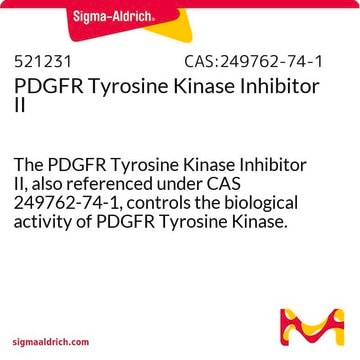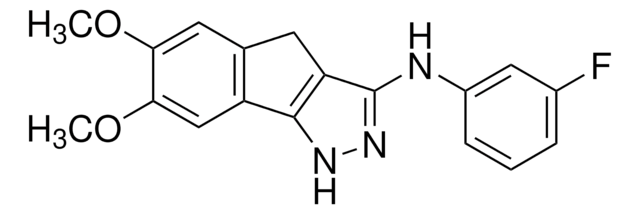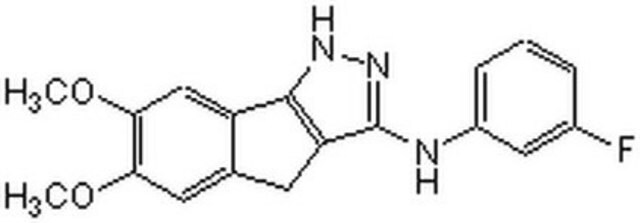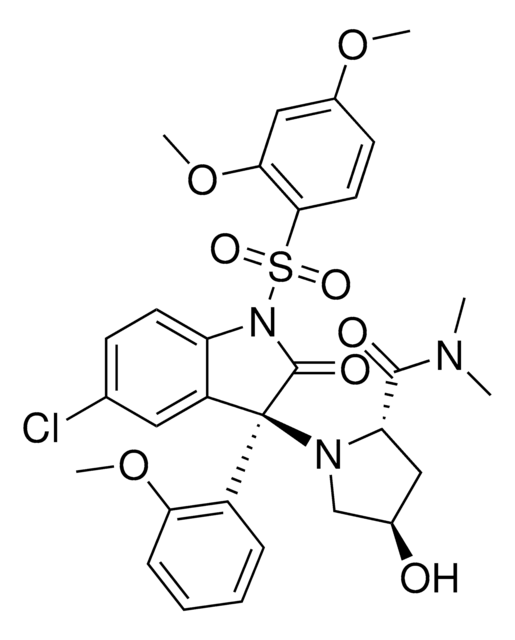521234
PDGFR Tyrosine Kinase Inhibitor V
The PDGFR Tyrosine Kinase Inhibitor V, also referenced under CAS 347155-76-4, controls the biological activity of PDGFR Tyrosine Kinase. This small molecule/inhibitor is primarily used for Phosphorylation & Dephosphorylation applications.
Synonym(s):
PDGFR Tyrosine Kinase Inhibitor V, N-(4-((6,7-Dimethoxy-4-quinoyl)oxy)phenyl)-Nʹ-(2-methylbenzoyl)thiourea, Ki11502
Sign Into View Organizational & Contract Pricing
All Photos(1)
About This Item
Empirical Formula (Hill Notation):
C26H23N3O4S · 3H2O
CAS Number:
Molecular Weight:
527.59
MDL number:
UNSPSC Code:
12352200
NACRES:
NA.77
Recommended Products
Quality Level
Assay
≥95% (HPLC)
form
solid
manufacturer/tradename
Calbiochem®
storage condition
OK to freeze
protect from light
color
off-white
solubility
DMSO: 25 mg/mL
shipped in
ambient
storage temp.
2-8°C
General description
A cell-permeable quinolinyl-thiourea compound that acts a potent, ATP-competitive, and reversible inhibitor of PDGFR (IC50 = 4 and 7.6 nM in ligand-induced cellular PDGFR phosphorylation and in in vitro kinase activity, respectively). Inhibits c-kit receptor only at much higher concentrations (IC50 = 434 and 234 nM in receptor phosphorylation and kinase activity, respectively). Shown to potently inhibit neointima formation in a rat carotid artery balloon injury model in vivo (30 mg/kg, p.o.).
Biochem/physiol Actions
Cell permeable: yes
Primary Target
PDGFR
PDGFR
Product competes with ATP.
Reversible: yes
Target IC50: 4 and 7.6 nM in ligand-induced cellular PDGFR phosphorylation and in in vitro kinase activity, respectively
Packaging
Packaged under inert gas
Warning
Toxicity: Toxic (F)
Reconstitution
Following reconstitution, aliquot and freeze (-20°C). Stock solutions are stable for up to 3 months at -20°C.
Other Notes
Due to the nature of the Hazardous Materials in this shipment, additional shipping charges may be applied to your order. Certain sizes may be exempt from the additional hazardous materials shipping charges. Please contact your local sales office for more information regarding these charges.
Getachew, R., et al. 2009. Eur. J. Pharmacol. In press.
Nishioka, C., et al. 2008. Blood111, 5086.
Furuta, T., et al. 2006. J. Med. Chem.49, 2186.
Nishioka, C., et al. 2008. Blood111, 5086.
Furuta, T., et al. 2006. J. Med. Chem.49, 2186.
Legal Information
CALBIOCHEM is a registered trademark of Merck KGaA, Darmstadt, Germany
Storage Class Code
11 - Combustible Solids
WGK
WGK 3
Flash Point(F)
Not applicable
Flash Point(C)
Not applicable
Certificates of Analysis (COA)
Search for Certificates of Analysis (COA) by entering the products Lot/Batch Number. Lot and Batch Numbers can be found on a product’s label following the words ‘Lot’ or ‘Batch’.
Already Own This Product?
Find documentation for the products that you have recently purchased in the Document Library.
Robel Getachew et al.
European journal of pharmacology, 626(2-3), 186-192 (2009-10-13)
Platelet-derived growth factor (PDGF) receptor signalling is implicated in cardiovascular diseases such as atherosclerosis and restenosis. PDGF expression levels are elevated in atherosclerotic lesions and play a key role in migration and proliferation of vascular smooth muscle cells in the
Chie Nishioka et al.
Blood, 111(10), 5086-5092 (2008-03-01)
Ki11502 is a novel multitargeted receptor tyrosine kinase (RTK) inhibitor with selectivity against platelet-derived growth factor receptor alpha/beta (PDGFRalpha/beta). Ki11502 (0.1-1 nM, 2 days) profoundly caused growth arrest, G(0)/G(1) cell-cycle arrest, and apoptosis associated with down-regulation of Bcl-2 family proteins
Takayuki Furuta et al.
Journal of medicinal chemistry, 49(7), 2186-2192 (2006-03-31)
We report the structure-activity relationship of quinoline and quinazoline derivatives, which include urea, thiourea, urethane, and acylthiourea groups, as inhibitors of the platelet-derived growth factor (PDGF) receptor autophosphorylation. Our previous studies showed that the quinoline and quinazoline derivatives including urea
Sclerotome-derived PDGF signaling functions as a niche cue responsible for primitive erythropoiesis.
Aihua Mao et al.
Development (Cambridge, England), 150(22) (2023-10-26)
Primitive erythropoiesis serves a vital role in embryonic development, generating primitive red blood cells responsible for transportation of oxygen throughout the body. Although diverse niche factors are known to function in definitive hematopoiesis, the microenvironment contributing to primitive hematopoiesis remains
Aihua Mao et al.
Journal of genetics and genomics = Yi chuan xue bao, 46(12), 551-559 (2020-01-25)
The great vessels of the heart originate from the pharyngeal arch arteries (PAAs). Anomalies of the PAAs often occur together with pharyngeal pouch malformations, but the reasons for this phenomenon are not fully understood. In the current study, we show
Our team of scientists has experience in all areas of research including Life Science, Material Science, Chemical Synthesis, Chromatography, Analytical and many others.
Contact Technical Service







